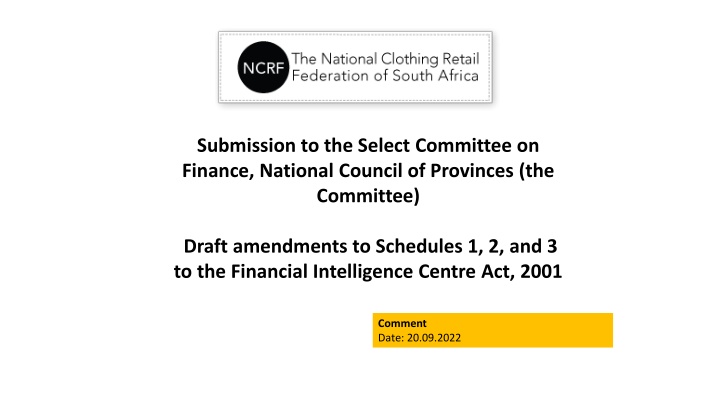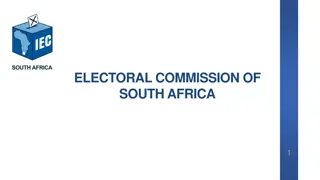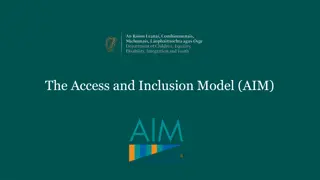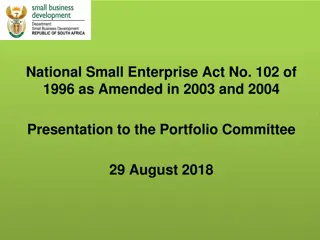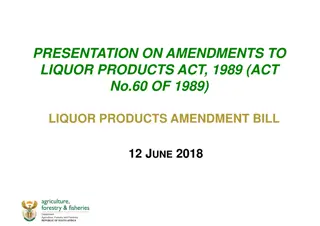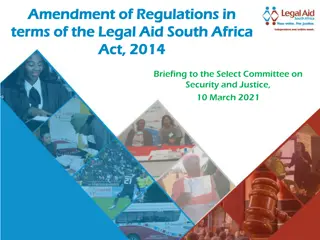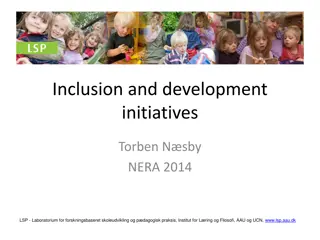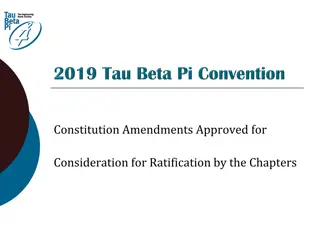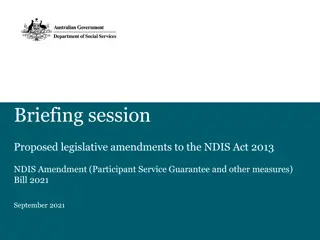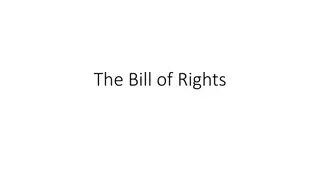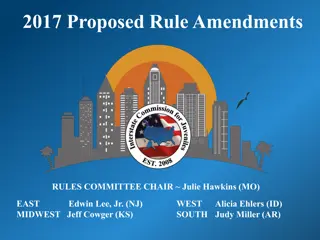Proposed Amendments to Financial Intelligence Centre Act, 2001: Addressing Credit Providers Inclusion
Proposed amendments to Schedules 1, 2, and 3 of the Financial Intelligence Centre Act, 2001, specifically focusing on the contentious inclusion of credit providers as defined in the National Credit Act, 2005, as accountable institutions. The background, concerns raised by stakeholders, and a proposed alternative wording for the amendment are discussed, highlighting adverse implications on consumers' access to credit and the challenges faced in meeting compliance requirements.
Uploaded on Jul 23, 2024 | 0 Views
Download Presentation

Please find below an Image/Link to download the presentation.
The content on the website is provided AS IS for your information and personal use only. It may not be sold, licensed, or shared on other websites without obtaining consent from the author.If you encounter any issues during the download, it is possible that the publisher has removed the file from their server.
You are allowed to download the files provided on this website for personal or commercial use, subject to the condition that they are used lawfully. All files are the property of their respective owners.
The content on the website is provided AS IS for your information and personal use only. It may not be sold, licensed, or shared on other websites without obtaining consent from the author.
E N D
Presentation Transcript
Submission to the Select Committee on Finance, National Council of Provinces (the Committee) Draft amendments to Schedules 1, 2, and 3 to the Financial Intelligence Centre Act, 2001 Comment Date: 20.09.2022
Draft amendment to Schedule 1 of the Financial Intelligence Centre Act, 2001 (FICA) Item 11(a): proposed inclusion of credit providers as defined in the National Credit Act, 2005 (NCA) as accountable institutions. Draft Item 11(a) currently reads as follows: A person who carries on the business of a credit provider as defined in the National Credit Act, 2005 (Act 34 of 2005)
Background NCRF made a submission to the Standing Committee on Finance of the National Assembly regarding the proposed change in Draft Item 11(a). The current draft amendment is based on a Financial Action Task Force (FATF) Standard which requires that the act of lending is to be included in the scope of a country s measures against money laundering and terrorist financing (MLTF). NCRF formally objects to the blanket inclusion of credit providers in Draft Item 11(a), in light of the drastic and materially adverse unintended consequences that an inclusion will have on both credit retailers and retail credit consumers.
PROPOSED ALTERNATIVE WORDING FOR ITEM 11(a) OF SCHEDULE 1 TO FICA A person who carries on the business of a credit provider as defined in the National Credit Act, 2005 (Act 34 of 2005), excluding credit providers offering credit as provided for in section 8(1)(a) read with section 8(3), in circumstances where the credit facility in question constitutes a closed-loop, revolving credit store card where a credit limit is available to the consumer and an instalment is payable monthly.
KEY ADVERSE PRACTICAL IMPLICATIONS SHOULD THE CURRENT DRAFT ITEM 11(A) BE IMPLEMENTED Inevitable exclusion of a large segment of South African consumers from access to safe and well-regulated credit o FICA requires accountable institutions to conduct appropriate, and ongoing, client due diligence (CDD) or know-your customer (KYC) processes, which include proof of residence. o Based on data published by the National Credit Regulator as it relates to the retail credit market for the 2021 calendar year: 11.33 million South African consumers applied for credit at retail stores. 5.4 million retail store credit facilities were granted, with an aggregate value of approximately R18 billion. equates to an average store credit facility value of R 3,348. o Practical reality is that 30% to 40% of consumers seeking retail credit will simply not be able to produce or provide proof of residence as would be required by FICA-imposed CDD / KYC. o Translates into the immediate exclusion of 3.399 million and 4.532 million South African consumers from the credit market, because they are not able to provide proof of residence. o The current Draft Item 11(a) of Schedule 1 of FICA: acts as a barrier for entry to the credit market is at odds with the stated aims and purposes of the NCA is contrary to National Treasury s own goals in terms of financial inclusion. o Similar impractical amendments to the NCA Regulations which effectively excluded informally-employed and self-employed consumers who did not have bank accounts from accessing credit were struck down in Truworths Ltd and Others v Minister of Trade and Industry and Another.1 1 2018 (3) SA 558 (WCC)]
KEY ADVERSE PRACTICAL IMPLICATIONS SHOULD THE CURRENT DRAFT ITEM 11(A) BE IMPLEMENTED Additional compliance costs to be borne by Draft Item 11(a) registered credit providers and, ultimately, by (credit and non-credit) consumers o NCRF estimates that the cost of adhering to FICA s basic due diligence requirements, should the current Draft Item 11(a) be implemented, would stand at at least R25.00 to R30.00 per credit applicant, translating into additional and ongoing hard costs for clothing retailers of between R275 million and R330 million. o These costs would materially impact the NCRF members and if absorbed by the retailer will directly impact retailer s profitability, thereby potentially jeopardising jobs and commitments to government to create jobs in the retail and manufacturing sector. o If the compliance costs are passed onto consumers, it would be by way of increased pricing of the retailer s merchandise which is an undesirable outcome in the current economic climate. o Compliance-cost burden should Draft Item 11 (a) be implanted is disproportionate to the level of MLFT risk relevant to the NCRF members retail store credit businesses.
POTENTIAL CONSTITUTIONAL ISSUES In my view, in discriminating against a section of the population that represents the less privileged, and probably also many previously disadvantaged persons, in a manner that is not fair, the regulation falls foul of s 14(2) and (3) of the Promotion of Equality and Prevention of Unfair Discrimination Act 4 of 2000. The applicants also submit that it contravenes s 9(3) of the Constitution in that it effectively discriminates on the basis of race. It is clear to me that this could never have been the intention of the Minister, but it may well be an unintended result. If so, it would offend against s 9(3), but I make no finding on this point. Truworths Ltd and Others v Minister of Trade and Industry and Another, par 53 Analogous situation: validation of gross income (proof of financial statements) [NCA] and proof of residence [FICA]. Similar indirect but unintended impact.
SUPPORT FOR THE ALTERNATIVE WORDING PROPOSED FOR ITEM 11(a) OF SCHEDULE 1 TO FICA Objectively low risk of MLTF o It appears the Financial Intelligence Centre (FIC) did not conduct a sector study for the inclusion of credit providers as accountable institutions, which if correct, is surprising and irrational. o Nature of the business being conducted by the NCRF members, in the form of retail store credit, translates into low MLTF risk. Perceived unequal treatment in the practical assessment of MLTF risk across different categories of accountable institutions, in terms of the currently proposed amendments. o Disjunct between high-value goods dealers who become accountable institutions at a transaction value of R100,000 or more and providers of a credit facility where the average facility value is R3,348. o Proposed alternative wording Draft Item 11(A) is far more proportionate relative to the mischief the proposal is seeking to prevent. o Botswana implemented a knee-jerk response as a result of FATF grey-listing which had untenable results and which has since been reversed. o NCRF strongly suggests that the Committee insist that the FIC conduct a MLTF risk assessment on the credit provider sector before item 11 of Schedule 1 to FICA is implemented.
SUPPORT FOR THE ALTERNATIVE WORDING PROPOSED FOR ITEM 11(a) OF SCHEDULE 1 TO FICA Other carve-outs of sectors are already catered for in Schedule 1 to FICA o Non-life insurers and authorised financial services providers who intermediate non-life insurance are excluded from being considered accountable institutions based on the low MLTF risk associated with the sectors. o As the MLTF risk brought about by the credit businesses of the NCRF s members is objectively low, the NCRF has a reasonable and legitimate expectation that its industry and its members will be afforded the same consideration and treatment as those already carved-out in Schedule 1 of FICA.
CONCLUSION The practical implications of the implementation of Draft Item 11(a) for credit providers as defined in the NCA and retail credit consumers alike are far-reaching, undesirable, unnecessary and drastic and it appears that these implications have not yet been adequately taken into account, nor due they appear proportional with the level of risk associated with the business of the NCRF members.
